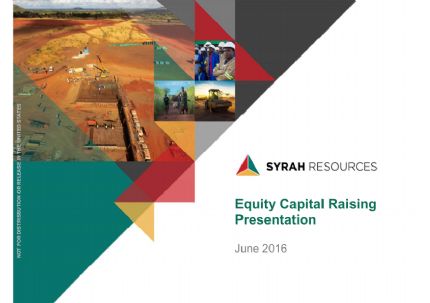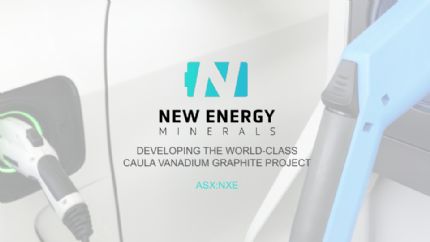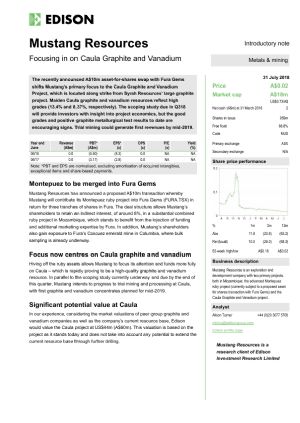 Ore Sorting Testwork Caula Project - Amendment
Ore Sorting Testwork Caula Project - Amendment
Sydney, June 15, 2018 AEST (ABN Newswire) - Mustang Resources ( ASX:MUS) (
ASX:MUS) ( MTTGF:OTCMKTS) is pleased to announce that it has received strong results from preliminary ore sorting testwork conducted on drill core from its Caula Graphite-Vanadium project in Mozambique.
MTTGF:OTCMKTS) is pleased to announce that it has received strong results from preliminary ore sorting testwork conducted on drill core from its Caula Graphite-Vanadium project in Mozambique.
This testwork demonstrated that the Caula ore is highly amenable to sensor-based ore sorting. Results showed that an ore sample with no visible waste could be split into high-grade and low-grade streams.
Key Points
- Preliminary ore sorting testwork was conducted by specialists TOMRA Sorting at its Test and Demonstration Centre at Castle Hill, NSW Australia
- X-Ray Transmission and Conductivity (EM) sorting were both evaluated
- The tests found:
o in a full-scale mining operation, EM sorting would efficiently reject barren waste with minimal loss of graphite or vanadium values
o a moderate-grade ore sample with no visible waste was successfully split into high-grade and low-grade fractions
o potential to use ore sorting to upgrade graphite and vanadium grades
- TOMRA recommends a larger-scale formal testwork program based on these strong results
- The results demonstrate the potential to increase production rates without increasing the plant size and to reduce operating costs
Both X-Ray Transmission and Conductivity-based (EM) sorting were evaluated with the EM sorting generating the best result. The EM sensors evaluate the proportion of electrically-conductive mineral (in this case graphite) in each rock particle. Vanadium values are closely associated with graphite and show a similar response to sorting.
Ore sorting enables waste rock and low-grade ore to be separated from run-of-mine ore. Sorting saves costs by rejecting waste rock and low-grade ore ahead of expensive processing steps such as milling and froth flotation. In many cases, sorting delivers additional environmental benefits to projects due to reduced tailings volumes, enhanced tailings storage stability and other factors.
High capacity, sensor-based ore sorting is an emerging technology which can deliver enormous value, particularly when considered for a new mining project. TOMRA has a successful track record in the mining industry with sensor-based sorting installations operating at feed rates ranging up to several hundred tonnes per hour. These systems are fully automated and have very low costs per tonne processed.
The Caula Project is located along strike from Syrah Resources' ( ASX:SYR) world-class Balama graphite project in Mozambique.
ASX:SYR) world-class Balama graphite project in Mozambique.
Sample Tested
The sample selected was a continuous portion of quartered NQ diamond drill core from 58m to 88m downhole in borehole MODD015. The sample was chosen to represent fresh ore with moderate grades of graphite and vanadium and no visible barren rock intersections.
Additional details of the drilling results from borehole MODD015 were given in the ASX announcement of 1 May 2018. The analysis results shown below in Tables 1,2 and 3 (see link below) are in line with the analyses given in the 1 May announcement.
Test Procedure
The selected quarter core sample with a total weight of 66kg was first broken into approximately 50mm lengths. It was then split into two portions using a rotary riffle and one of these portions, with a weight of about 30kg, was sent to the TOMRA Test and Demonstration Centre at Castle Hill, NSW Australia.
At TOMRA, the sample was screened at 16 mm to remove fines ahead of sorting tests. About 30% of the sample reported to fines. The screen oversize was then subject to sorting tests on both XRT and EM based machines. After discussion of preliminary results with Mustang, the sorting parameters of each machines were adjusted to give an approximate 50% mass split between concentrate and reject.
The screen oversize material was then recombined before being split into two portions. One of these portions as sorted by XRT, the other by EM. With the screen undersize, this gave 5 product samples which were returned to Nagrom Laboratories in Perth for analysis.
The samples were individually crushed and blended. Analysis samples were then split out and sent for graphite analysis, multi element XRF analysis and semi-quantitative XRD mineral analysis.
Results
The graphite and vanadium analyses of the five products from testwork are shown below in Table 1 (see link below). The final row in this table shows the feed grade calculated from the weighted average of the individual sample data.
The mass split and the distribution of contained graphite and vanadium between the five samples was calculated from the data shown in Table 1 (see link below). Results of this calculation are shown graphically in Figure 1 (see link below).
It can be seen that the unsorted fine material was significantly enriched in both graphite and vanadium. This is not surprising as the graphite-rich zones of ore tend to be quite friable compared with lower grade zones. It is also immediately apparent that the EM sorting achieved greater levels of separation of graphite and vanadium values than the XRT sorting.
Sorting performance results were calculated by apportioning the screen undersize between the EM and XRT tests based on the weight of screen oversize used in each test. Screen undersize and the high-grade material from the sorting were then combined to give an overall high-grade stream. The low-value material from the sorting was then classified as the low-grade stream. This gives the results shown in Tables 2 and 3 (see link below) for the EM and XRT Sort runs respectively.
To view tables and figures, please visit:
http://abnnewswire.net/lnk/G0PM60N0
About New Energy Minerals Ltd
 New Energy Minerals Ltd (ASX:NXE) (FRA:GGY) is an ASX listed junior mining company, that recently announced the divestment of the Company's Caula vanadium - graphite project and the Montepuez Ruby project in Mozambique.
New Energy Minerals Ltd (ASX:NXE) (FRA:GGY) is an ASX listed junior mining company, that recently announced the divestment of the Company's Caula vanadium - graphite project and the Montepuez Ruby project in Mozambique.

![abnnewswire.com]()
Related Companies
Social Media
Share this Article

 ASX:MUS) (
ASX:MUS) ( MTTGF:OTCMKTS) is pleased to announce that it has received strong results from preliminary ore sorting testwork conducted on drill core from its Caula Graphite-Vanadium project in Mozambique.
MTTGF:OTCMKTS) is pleased to announce that it has received strong results from preliminary ore sorting testwork conducted on drill core from its Caula Graphite-Vanadium project in Mozambique.  ASX:SYR) world-class Balama graphite project in Mozambique.
ASX:SYR) world-class Balama graphite project in Mozambique.  New Energy Minerals Ltd (ASX:NXE) (FRA:GGY) is an ASX listed junior mining company, that recently announced the divestment of the Company's Caula vanadium - graphite project and the Montepuez Ruby project in Mozambique.
New Energy Minerals Ltd (ASX:NXE) (FRA:GGY) is an ASX listed junior mining company, that recently announced the divestment of the Company's Caula vanadium - graphite project and the Montepuez Ruby project in Mozambique.












